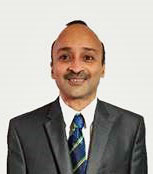Packaging of Bioelectronic Implants: Key Building Blocks and Recent Advances 🗓
Speaker: P M Raj, Florida International University, Miami
Meeting Date: Thursday, September 15, 2022
Location: On the Internet
Time: Checkin via WebEx at 1:50 PM; Presentation at 2:00 PM (CDT)
Cost: none
Reservations: eps2209.eventbrite.com
Summary: Bioelectronic implants rely on wireless power and data telemetry for detecting physiological signals and communicating them to an external reader or an implanted module for close-loop therapeutic solutions. Sensor fusion and wireless connectivity with external electronic readers through simplified circuit topologies, advanced telemetry components for better signal sensitivity at low power, and 3D package integration for miniaturization and reliability are the main barriers for wireless neural recording. On the other hand, power telemetry and capacitor integration, high-density electrode arrays with high charge-injection and low impedance are critical for neurostimulation. This talk will highlight advances in the component and embedding technologies to realize performance, long-term stability and reliability while meeting the critical system scaling trends in bioelectronic implants. The talk will specifically cover key building blocks: a)Telemetry components and their heterogeneous integration to meet the power density and data rate needs, b) Bioelectronic component embedding with flexible fan-out interconnections, c) Low-impedance electrodes or impedance-transforming signal interfaces for better signal sensitivity, d)hermetic feedthroughs and remateable connectors to achieve the performance and reliability targets with robustness. The impact of these building blocks in creating future neurotechnologies will be illustrated through specific examples.
 Bio: P. M. Raj’s expertise is in packaging of electronic and bioelectronic systems, with emphasis on nanoscale RF, power and bioelectronic components, and active and passive integration in ultrathin embedded modules. He is an Associate Professor in Biomedical Engineering and Electrical and Computer Engineering at Florida International University. He demonstrated several electronic packaging technologies, working with the whole electronic ecosystem, which include several semiconductor, packaging and material, tool, and end-user companies. He is widely recognized for his contributions in integrated passive components and technology roadmapping, component integration for bioelectronic, power and RF modules, and also for promoting the role of nanomaterials and nanostructures for electronics packaging applications through IEEE NTC and EPS activities. His research led to more than 340 publications, which include 8 patents. He co-advised and mentored more than 30 MS and PhD students who are current leaders and technology pioneers in the electronic packaging industry. He received ~30 best-paper awards in IEEE packaging and nanotechnology conferences and workshops. He delivered several invited lectures and offered several industry short courses. He is the Chair of Nanopackaging Technical Committee, EPS Representative of IEEE Nanotechnology Council, IEEE Distinguished Lecturer in Nanotechnology for 2020-2021, Associate Editor for IEEE Nanotechnology Magazine and Transactions of Components, Packaging and Manufacturing Technologies (T-CPMT). He earned his PhD from Rutgers University in 1999 in Ceramic Engineering, ME from the Indian Institute of Science, Bangalore and BS from the Indian Institute of Technology, Kanpur (1993).
Bio: P. M. Raj’s expertise is in packaging of electronic and bioelectronic systems, with emphasis on nanoscale RF, power and bioelectronic components, and active and passive integration in ultrathin embedded modules. He is an Associate Professor in Biomedical Engineering and Electrical and Computer Engineering at Florida International University. He demonstrated several electronic packaging technologies, working with the whole electronic ecosystem, which include several semiconductor, packaging and material, tool, and end-user companies. He is widely recognized for his contributions in integrated passive components and technology roadmapping, component integration for bioelectronic, power and RF modules, and also for promoting the role of nanomaterials and nanostructures for electronics packaging applications through IEEE NTC and EPS activities. His research led to more than 340 publications, which include 8 patents. He co-advised and mentored more than 30 MS and PhD students who are current leaders and technology pioneers in the electronic packaging industry. He received ~30 best-paper awards in IEEE packaging and nanotechnology conferences and workshops. He delivered several invited lectures and offered several industry short courses. He is the Chair of Nanopackaging Technical Committee, EPS Representative of IEEE Nanotechnology Council, IEEE Distinguished Lecturer in Nanotechnology for 2020-2021, Associate Editor for IEEE Nanotechnology Magazine and Transactions of Components, Packaging and Manufacturing Technologies (T-CPMT). He earned his PhD from Rutgers University in 1999 in Ceramic Engineering, ME from the Indian Institute of Science, Bangalore and BS from the Indian Institute of Technology, Kanpur (1993).

